-
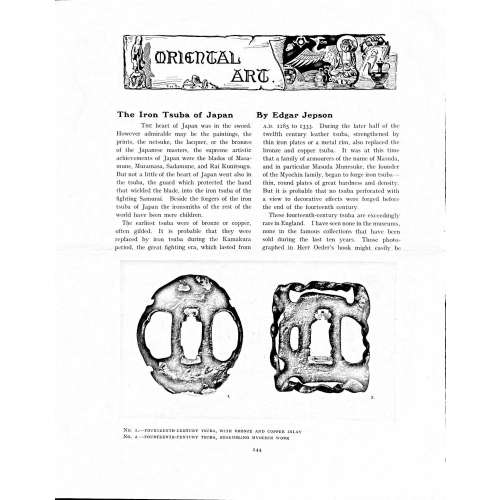 Magazine article by Edgar Jepson: The Iron Tsuba of Japan (Section: Oriental Art), published in volume Vol. 70 (September–December) of The Connoisseur: An Illustrated Magazine for Collectors, Vol. 70 (September–December); pp. 143-152 / C. Reginald Grundy [ed.] — London: Published by the Proprietor, W. CLAUSE JOHNSON, at the Editorial and Advertisement Offices of The Connoisseur, 1924. Owner's half black morocco, gilt lettering to spine, blue cloth boards. Two volumes bound together without original covers. Size 28.5 x 22 cm. Vol. 1: The Connoisseur | An Illustrated Magazine | For Collectors | Edited by C. Reginald Grundy | Vol. LXIX. | (MAY—AUGUST, 1924) | LONDON | Published by the Proprietor, W. CLAUSE JOHNSON, at the | Editorial and Advertisement Offices of The Connoisseur, | at 1, Duke Street, St. James's, S.W. 1 | 1924 || Pp.: [i-ii] iii-xviii [xix] [1, 2 - plate] 3-249 [250]. Vol. 2: The Connoisseur | An Illustrated Magazine | For Collectors | Edited by C. Reginald Grundy | Vol. LXX. | (SEPTEMBER—DECEMBER, 1924) | LONDON | Published by the Proprietor, W. CLAUSE JOHNSON, at the | Editorial and Advertisement Offices of The Connoisseur, | at 1, Duke Street, St. James's, S.W. 1 | 1924 || Pp.: [i-ii] iii-xxii [2 blanks] [1, 2 - plate] 3-261 [262]. The Iron Tsuba of Japan by Edgar Jepson The heart of Japan was in the sword. However admirable may be the paintings, the prints, the netsuke, the lacquer, or the bronzes of the Japanese masters, the supreme artistic achievements of Japan were the blades of Masamune, Muramasa, Sadamune, and Rai Kunitsugu. But not a little of the heart of Japan went also in the tsuba, the guard which protected the hand that wielded the blade, into the iron tsuba of the fighting Samurai. Beside the forgers of the iron tsuba of Japan the ironsmiths of the rest of the world have been mere children. The earliest tsuba were of bronze or copper, often gilded. It is probable that they were replaced by iron tsuba during the Kamakura period, the great fighting era, which lasted from A.D. 1185 to 1333. During the later half of the twelfth century leather tsuba, strengthened by thin iron plates or a metal rim, also replaced the bronze and copper tsuba. It was at this time that a family of armourers of the name of Masuda, and in particular Masuda Munesuke, the founder of the Myochin family, began to forge iron tsuba — thin, round plates of great hardness and density. But it is probable that no tsuba perforated with a view to decorative effects were forged before the end of the fourteenth century. These fourteenth-century tsuba are exceedingly rare in England. I have seen none in the museums, none in the famous collections that have been sold during the last ten years. Those photographed in Herr Oeder's book might easily be the fifteenth century. No. 1 is a curious cup-shape tsuba decorated with a bronze and copper inlay. No. 2, with its edges curiously twisted in the forging, looks like Myochin work. But it is not of the Myochin iron. The Myochin family produced some of the greatest ironsmiths of Japan. Armourers first of all, tsubasmiths, forgers of sake-kettles, articulated reptiles, crustacea, and insects — everything that can be done with iron they did; they pushed their medium to its limit. They were forging iron tsuba in 1160, and they were still forging them in 1860. And it was their own iron, or rather their own steel. They discovered the secret of it early, and they kept that secret in the family for all those hundreds of years. There is no mistaking a Myochin tsuba: balance it on your finger and tap it with a piece of metal, always it gives forth a clear bell-like ring that you get from the work of no other ironsmith, Japanese or European. Always the Myochin tsuba is before everything a protection to the hand of the swordsman; to that everything is, as it should be, subordinated. No. 3 is a Myochin tsuba of the fifteenth century, and probably of the early fifteenth century. No. 4, by Myochin Munetaka, perforated with a grotesque figure, is an example of that twisting and twisting of the iron in the forging till it forms a pattern like the grain of wood. The Myochin smiths invented these wood-grain tsuba, and no other smiths equalled them in their forging. In the sixteenth century, the fighting tsuba was probably at its best. It was a century of great tsubasmiths. Then the first Nobuiye, whose tsuba fetched £100 apiece, circa 1800, in Japan, and the first Kaneiye flourished. No. 5 is a tsuba forged by a great smith, Iyesada of Sotome, in the manner of Nobuiye I, decorated with the karakusa tendrils that Nobuiye delighted in, with lightning and clouds. No. 6 is a guard of Sanada Tembo, the chief smith of the Tembo family, stamped, punning fashion, with the character Tembo. Akin to the Tembo tsuba were those of the Kiami and Hoan smiths. Then also the Heianjo smiths and the Owari smiths, especially those of Nagoya and the Yamakichi family, forged their strongest tsuba. Those of the Yamakichi were tested after the forging by being pounded in iron mortars — at least, so the legend runs. But they were a sternly utilitarian family, and I have never seen a Yamakichi tsuba of any beauty. In the later half of the fifteenth century arose the fashion of decorating tsuba with an inlay, zogan, of bronze. The Heianjo tsuba, forged at Kyoto in the latter half of the fifteenth and the beginning of the sixteenth century, were often thus inlaid. The earliest of them were called "Onin", of which No. 7 is an example. In addition to the bronze inlay around the edge, it is inlaid with a representation, some say, of snow; others say, of the duckweed on a pond. No. 8 is probably a Heianjo tsuba, but I am not quite sure about it. The inlaid acacia branches might be very early Shoami work. But to judge by the iron, it is a fifteenth-century tsuba; and the authorities place the beginning of the Shoami school not later than early in the sixteenth century. No. 10 is an example of the Fushimi-zogan, a flat inlay of a light-coloured bronze. These tsuba took their name from the fact that they were first forged at Fushimi, in Yamashiro, in the sixteenth century. It is of the type known as Mon-zukashi, perforated with crests (mon) à jour. The Yoshiro-zogan tsuba were also first forged at Fushimi by Yoshiro Naomasa. They were distinguished from the Fushimi-zogan by the fact that their inlay was generally a little raised-not always-for the inlay of No. 9, a tsuba forged by a later nineteenth-century Yoshiro, is quite flat. It is an interesting tsuba, for, with its decoration grown florid and excessive, it marks the intermediate stage between the simple and delightful designs of the genuine fighting tsuba and the elaborate pictures in gold and silver on the tsuba of the eighteenth-century smiths of Awa and Kyoto, which have become mere ornaments of the goldsmith. The Gomoku-zogan (No. 11) tsuba were probably first forged earlier than the Fushimi and Yoshiro-zogan tsuba. This inlay, in slight relief, is a representation in a light-coloured bronze and copper of twigs caught in the eddies of streams. The seventeenth century and early eighteenth century were the great periods of perforated tsuba. The designs, and they are often admirable, are for the most part in plain fretwork; but they are also chased. No. 12, a crane under an acacia, is a tsuba of a Higo smith, great forgers of fighting tsuba during this period. These smiths also excelled in nunome zogan, a very thin gold and silver inlay, with which they further decorated their perforated guards. The smiths of the Umetada and Shoami families also forged iron tsuba during this period; but their designs, though sometimes pleasing enough, are rarely fine. The best work of Myoju Umetada is in sentoku, not iron. The Choshu smiths, coming later, surpass the perforated guards of both the Umetada and Shoami smiths in beauty of design. No. 13, a lotus in the round, not only fretwork, but also engraved, is a good example of the admirable balance they so often attained in their designs. It is a sufficiently realistic lotus, but yet of a delightful simplicity. In considerable contrast is No. 14, the dragon by Soheishi Soten — one of the only two authentic tsuba of his forging known — the first forger of hikone-bori tsuba, which were in extraordinary favour in Japan during the eighteenth century, and illustrated every important event in Japanese history. It is on the elaborate side, but fine, strong work, and an excellent guard to the hand, for the lighter and more open part, which gives the design its admirable balance, is on the inside, and not exposed to the full swing of an opponent's blade. A few years ago there was a tendency to decry the Namban tsuba as having sprung too directly from foreign sources. But though the original suggestion may have been Chinese, or, as some say, Portuguese, the Japanese made it entirely their own, as characteristically Japanese as anything can well be, but, it must be admitted, of a decadent period. The school took its rise at the beginning of the seventeenth century, and the early tsuba were forged of a specially hard iron, the Wootz, imported from Southern India. No. 15, the signs of the Zodiac, is an excellent tsuba from the fighting point of view. Both it and No. 16 are of quite charming, if elaborate, design, and both of them, with their delicate scroll-work, so astonishingly undercut, are the very last word in the work of the ironsmith-veritable iron lace. To return to the simpler perforated tsuba, the smiths of Akasaka, a suburb of Tokyo, produced probably the most charming designs. Their style derives considerably from the Higo smiths, and their earlier fighting tsuba are very like the Higo tsuba. But always their work was just a little lighter than that of the Higo smiths, and in the end they moved right away from them and became the forgers of very light guards indeed. No. 17, is a representation of the Hiyokudori, the fabulous double bird, in which were reincarnated the souls of the two lovers, Gompachi and Komurasaki; and No. 18, “the tsuba of a hundred ducks "— there are about forty — are characteristic designs of the school. In the work of the Akasaka smiths the balance, which makes the design of a good tsuba so admirable and delightful, attains its height. This admirable balance seems often to be obtained by a deliberate sacrifice of symmetry. About nine hundred and ninety-nine European ironsmiths out of a thousand would have made the right and left sides of the Hiyoku-dori line by line, and perforation by perforation, exactly alike; he would have cut out exactly as many ducks on the one side of “the tsuba of a hundred ducks” as on the other, and made each duck on the right side correspond exactly in position and attitude with a duck on the left side. By variations the tsubasmith attained a finer balance, almost a higher symmetry. No. 19, often called by collectors the "rose-window" tsuba, but really a stylised chrysanthemum, is a favourite design of the Akasaka smiths, but Hizen work and inlaid in the Hizen manner with gold nunome. No. 20 is a Satsuma tsuba of the middle period. The Satsuma smiths of the nineteenth century produced probably the most ornate of all the iron guards, for the most part calibashes and beans with their leaves and tendrils realistic in the extreme, but of charming design. Few crafts have been carried further than that of the tsubasmith; few crafts working in a difficult medium have handled more subjects with greater feeling for beauty or greater liveliness of fancy. It is interesting to note again and again how school influences school, and smith influences smith. But, as in all the applied arts, the finest tsuba were forged by men who never lost sight of the purpose of a tsuba, that it is before everything a protection to the hand, and never subjected that purpose to a passion for virtuosity. Illustrations: No 1. FOURTEENTH-CENTURY TSUBA, WITH BRONZE AND COPPER INLAY No. 2. FOURTEENTH-CENTURY TSUBA, RESEMBLING MYOCHIN WORK No. 3. MYOCHIN TSUBA, FIFTEENTH CENTURY No. 4. MYOCHIN TSUBA, NINETEENTH CENTURY No. 5. SIXTEENTH-CENTURY TSUBA No. 6. SIXTEENTH-CENTURY TSUBA BY IYESADA OF SOTOME BY SANADA TEMBO No. 7. ONIN TSUBA No. 8. HEIANJO (?) TSUBA No. 9. YOSHIRO TSUBA, NINETEENTH CENTURY No. 10. FUSHIMI-ZOGAN, NINETEENTH CENTURY No. 11.- GOMOKU-ZOGAN, SIXTEENTH CENTURY No. 12. HIGO TSUBA, SEVENTEENTH CENTURY No. 13. CHOSHU TSUBA, SEVENTEENTH CENTURY No. 14. SOTEN TSUBA, SEVENTEENTH CENTURY No. 15. NAMBAN TSUBA, EIGHTEENTH CENTURY No. 16. NAMBAN TSUBA, NINETEENTH CENTURY Nos. 17. AND 18. AKASAKA TSUBA, EIGHTEENTH CENTURY No. 19. HIZEN TSUBA, EIGHTEENTH CENTURY No. 20. SATSUMA TSUBA, EIGHTEENTH CENTURY
Magazine article by Edgar Jepson: The Iron Tsuba of Japan (Section: Oriental Art), published in volume Vol. 70 (September–December) of The Connoisseur: An Illustrated Magazine for Collectors, Vol. 70 (September–December); pp. 143-152 / C. Reginald Grundy [ed.] — London: Published by the Proprietor, W. CLAUSE JOHNSON, at the Editorial and Advertisement Offices of The Connoisseur, 1924. Owner's half black morocco, gilt lettering to spine, blue cloth boards. Two volumes bound together without original covers. Size 28.5 x 22 cm. Vol. 1: The Connoisseur | An Illustrated Magazine | For Collectors | Edited by C. Reginald Grundy | Vol. LXIX. | (MAY—AUGUST, 1924) | LONDON | Published by the Proprietor, W. CLAUSE JOHNSON, at the | Editorial and Advertisement Offices of The Connoisseur, | at 1, Duke Street, St. James's, S.W. 1 | 1924 || Pp.: [i-ii] iii-xviii [xix] [1, 2 - plate] 3-249 [250]. Vol. 2: The Connoisseur | An Illustrated Magazine | For Collectors | Edited by C. Reginald Grundy | Vol. LXX. | (SEPTEMBER—DECEMBER, 1924) | LONDON | Published by the Proprietor, W. CLAUSE JOHNSON, at the | Editorial and Advertisement Offices of The Connoisseur, | at 1, Duke Street, St. James's, S.W. 1 | 1924 || Pp.: [i-ii] iii-xxii [2 blanks] [1, 2 - plate] 3-261 [262]. The Iron Tsuba of Japan by Edgar Jepson The heart of Japan was in the sword. However admirable may be the paintings, the prints, the netsuke, the lacquer, or the bronzes of the Japanese masters, the supreme artistic achievements of Japan were the blades of Masamune, Muramasa, Sadamune, and Rai Kunitsugu. But not a little of the heart of Japan went also in the tsuba, the guard which protected the hand that wielded the blade, into the iron tsuba of the fighting Samurai. Beside the forgers of the iron tsuba of Japan the ironsmiths of the rest of the world have been mere children. The earliest tsuba were of bronze or copper, often gilded. It is probable that they were replaced by iron tsuba during the Kamakura period, the great fighting era, which lasted from A.D. 1185 to 1333. During the later half of the twelfth century leather tsuba, strengthened by thin iron plates or a metal rim, also replaced the bronze and copper tsuba. It was at this time that a family of armourers of the name of Masuda, and in particular Masuda Munesuke, the founder of the Myochin family, began to forge iron tsuba — thin, round plates of great hardness and density. But it is probable that no tsuba perforated with a view to decorative effects were forged before the end of the fourteenth century. These fourteenth-century tsuba are exceedingly rare in England. I have seen none in the museums, none in the famous collections that have been sold during the last ten years. Those photographed in Herr Oeder's book might easily be the fifteenth century. No. 1 is a curious cup-shape tsuba decorated with a bronze and copper inlay. No. 2, with its edges curiously twisted in the forging, looks like Myochin work. But it is not of the Myochin iron. The Myochin family produced some of the greatest ironsmiths of Japan. Armourers first of all, tsubasmiths, forgers of sake-kettles, articulated reptiles, crustacea, and insects — everything that can be done with iron they did; they pushed their medium to its limit. They were forging iron tsuba in 1160, and they were still forging them in 1860. And it was their own iron, or rather their own steel. They discovered the secret of it early, and they kept that secret in the family for all those hundreds of years. There is no mistaking a Myochin tsuba: balance it on your finger and tap it with a piece of metal, always it gives forth a clear bell-like ring that you get from the work of no other ironsmith, Japanese or European. Always the Myochin tsuba is before everything a protection to the hand of the swordsman; to that everything is, as it should be, subordinated. No. 3 is a Myochin tsuba of the fifteenth century, and probably of the early fifteenth century. No. 4, by Myochin Munetaka, perforated with a grotesque figure, is an example of that twisting and twisting of the iron in the forging till it forms a pattern like the grain of wood. The Myochin smiths invented these wood-grain tsuba, and no other smiths equalled them in their forging. In the sixteenth century, the fighting tsuba was probably at its best. It was a century of great tsubasmiths. Then the first Nobuiye, whose tsuba fetched £100 apiece, circa 1800, in Japan, and the first Kaneiye flourished. No. 5 is a tsuba forged by a great smith, Iyesada of Sotome, in the manner of Nobuiye I, decorated with the karakusa tendrils that Nobuiye delighted in, with lightning and clouds. No. 6 is a guard of Sanada Tembo, the chief smith of the Tembo family, stamped, punning fashion, with the character Tembo. Akin to the Tembo tsuba were those of the Kiami and Hoan smiths. Then also the Heianjo smiths and the Owari smiths, especially those of Nagoya and the Yamakichi family, forged their strongest tsuba. Those of the Yamakichi were tested after the forging by being pounded in iron mortars — at least, so the legend runs. But they were a sternly utilitarian family, and I have never seen a Yamakichi tsuba of any beauty. In the later half of the fifteenth century arose the fashion of decorating tsuba with an inlay, zogan, of bronze. The Heianjo tsuba, forged at Kyoto in the latter half of the fifteenth and the beginning of the sixteenth century, were often thus inlaid. The earliest of them were called "Onin", of which No. 7 is an example. In addition to the bronze inlay around the edge, it is inlaid with a representation, some say, of snow; others say, of the duckweed on a pond. No. 8 is probably a Heianjo tsuba, but I am not quite sure about it. The inlaid acacia branches might be very early Shoami work. But to judge by the iron, it is a fifteenth-century tsuba; and the authorities place the beginning of the Shoami school not later than early in the sixteenth century. No. 10 is an example of the Fushimi-zogan, a flat inlay of a light-coloured bronze. These tsuba took their name from the fact that they were first forged at Fushimi, in Yamashiro, in the sixteenth century. It is of the type known as Mon-zukashi, perforated with crests (mon) à jour. The Yoshiro-zogan tsuba were also first forged at Fushimi by Yoshiro Naomasa. They were distinguished from the Fushimi-zogan by the fact that their inlay was generally a little raised-not always-for the inlay of No. 9, a tsuba forged by a later nineteenth-century Yoshiro, is quite flat. It is an interesting tsuba, for, with its decoration grown florid and excessive, it marks the intermediate stage between the simple and delightful designs of the genuine fighting tsuba and the elaborate pictures in gold and silver on the tsuba of the eighteenth-century smiths of Awa and Kyoto, which have become mere ornaments of the goldsmith. The Gomoku-zogan (No. 11) tsuba were probably first forged earlier than the Fushimi and Yoshiro-zogan tsuba. This inlay, in slight relief, is a representation in a light-coloured bronze and copper of twigs caught in the eddies of streams. The seventeenth century and early eighteenth century were the great periods of perforated tsuba. The designs, and they are often admirable, are for the most part in plain fretwork; but they are also chased. No. 12, a crane under an acacia, is a tsuba of a Higo smith, great forgers of fighting tsuba during this period. These smiths also excelled in nunome zogan, a very thin gold and silver inlay, with which they further decorated their perforated guards. The smiths of the Umetada and Shoami families also forged iron tsuba during this period; but their designs, though sometimes pleasing enough, are rarely fine. The best work of Myoju Umetada is in sentoku, not iron. The Choshu smiths, coming later, surpass the perforated guards of both the Umetada and Shoami smiths in beauty of design. No. 13, a lotus in the round, not only fretwork, but also engraved, is a good example of the admirable balance they so often attained in their designs. It is a sufficiently realistic lotus, but yet of a delightful simplicity. In considerable contrast is No. 14, the dragon by Soheishi Soten — one of the only two authentic tsuba of his forging known — the first forger of hikone-bori tsuba, which were in extraordinary favour in Japan during the eighteenth century, and illustrated every important event in Japanese history. It is on the elaborate side, but fine, strong work, and an excellent guard to the hand, for the lighter and more open part, which gives the design its admirable balance, is on the inside, and not exposed to the full swing of an opponent's blade. A few years ago there was a tendency to decry the Namban tsuba as having sprung too directly from foreign sources. But though the original suggestion may have been Chinese, or, as some say, Portuguese, the Japanese made it entirely their own, as characteristically Japanese as anything can well be, but, it must be admitted, of a decadent period. The school took its rise at the beginning of the seventeenth century, and the early tsuba were forged of a specially hard iron, the Wootz, imported from Southern India. No. 15, the signs of the Zodiac, is an excellent tsuba from the fighting point of view. Both it and No. 16 are of quite charming, if elaborate, design, and both of them, with their delicate scroll-work, so astonishingly undercut, are the very last word in the work of the ironsmith-veritable iron lace. To return to the simpler perforated tsuba, the smiths of Akasaka, a suburb of Tokyo, produced probably the most charming designs. Their style derives considerably from the Higo smiths, and their earlier fighting tsuba are very like the Higo tsuba. But always their work was just a little lighter than that of the Higo smiths, and in the end they moved right away from them and became the forgers of very light guards indeed. No. 17, is a representation of the Hiyokudori, the fabulous double bird, in which were reincarnated the souls of the two lovers, Gompachi and Komurasaki; and No. 18, “the tsuba of a hundred ducks "— there are about forty — are characteristic designs of the school. In the work of the Akasaka smiths the balance, which makes the design of a good tsuba so admirable and delightful, attains its height. This admirable balance seems often to be obtained by a deliberate sacrifice of symmetry. About nine hundred and ninety-nine European ironsmiths out of a thousand would have made the right and left sides of the Hiyoku-dori line by line, and perforation by perforation, exactly alike; he would have cut out exactly as many ducks on the one side of “the tsuba of a hundred ducks” as on the other, and made each duck on the right side correspond exactly in position and attitude with a duck on the left side. By variations the tsubasmith attained a finer balance, almost a higher symmetry. No. 19, often called by collectors the "rose-window" tsuba, but really a stylised chrysanthemum, is a favourite design of the Akasaka smiths, but Hizen work and inlaid in the Hizen manner with gold nunome. No. 20 is a Satsuma tsuba of the middle period. The Satsuma smiths of the nineteenth century produced probably the most ornate of all the iron guards, for the most part calibashes and beans with their leaves and tendrils realistic in the extreme, but of charming design. Few crafts have been carried further than that of the tsubasmith; few crafts working in a difficult medium have handled more subjects with greater feeling for beauty or greater liveliness of fancy. It is interesting to note again and again how school influences school, and smith influences smith. But, as in all the applied arts, the finest tsuba were forged by men who never lost sight of the purpose of a tsuba, that it is before everything a protection to the hand, and never subjected that purpose to a passion for virtuosity. Illustrations: No 1. FOURTEENTH-CENTURY TSUBA, WITH BRONZE AND COPPER INLAY No. 2. FOURTEENTH-CENTURY TSUBA, RESEMBLING MYOCHIN WORK No. 3. MYOCHIN TSUBA, FIFTEENTH CENTURY No. 4. MYOCHIN TSUBA, NINETEENTH CENTURY No. 5. SIXTEENTH-CENTURY TSUBA No. 6. SIXTEENTH-CENTURY TSUBA BY IYESADA OF SOTOME BY SANADA TEMBO No. 7. ONIN TSUBA No. 8. HEIANJO (?) TSUBA No. 9. YOSHIRO TSUBA, NINETEENTH CENTURY No. 10. FUSHIMI-ZOGAN, NINETEENTH CENTURY No. 11.- GOMOKU-ZOGAN, SIXTEENTH CENTURY No. 12. HIGO TSUBA, SEVENTEENTH CENTURY No. 13. CHOSHU TSUBA, SEVENTEENTH CENTURY No. 14. SOTEN TSUBA, SEVENTEENTH CENTURY No. 15. NAMBAN TSUBA, EIGHTEENTH CENTURY No. 16. NAMBAN TSUBA, NINETEENTH CENTURY Nos. 17. AND 18. AKASAKA TSUBA, EIGHTEENTH CENTURY No. 19. HIZEN TSUBA, EIGHTEENTH CENTURY No. 20. SATSUMA TSUBA, EIGHTEENTH CENTURY -
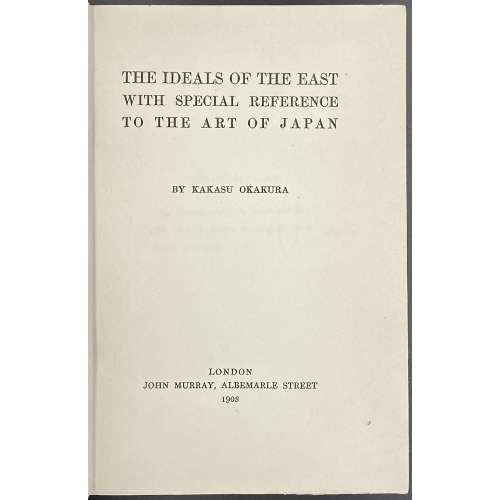 Title: THE IDEALS OF THE EAST | WITH SPECIAL REFERENCE | TO THE ART OF JAPAN | BY KAKASU OKAKURA | LONDON | JOHN MURRAY, ALBEMARLE STREET | 1903 || Collation: 8vo; ffl, [2] (t.p., prep. note) [a]4 b4, A-P8 Q4. Pagination: ffl, [I, ii] – h.t. / blank, [iii, iv] – t.p. / blank, [v, vi] – preparatory note / blank, vii-xxii, [1] 2-244, [1] 2-4 (Works for art lovers). Binding: Burgundy cloth, red flowers and lettering to cover, gilt lettering to spine. Size: 19.5 x 13 cm Contributors: Author: Okakura Kakuzō [岡倉 覚三] (1863 – 1913). Publisher: Murray, Sir John IV (1851–1928); John Murray (publishing house). Printer: Ballantyne, Hanson & Co., Edinburgh, London.
Title: THE IDEALS OF THE EAST | WITH SPECIAL REFERENCE | TO THE ART OF JAPAN | BY KAKASU OKAKURA | LONDON | JOHN MURRAY, ALBEMARLE STREET | 1903 || Collation: 8vo; ffl, [2] (t.p., prep. note) [a]4 b4, A-P8 Q4. Pagination: ffl, [I, ii] – h.t. / blank, [iii, iv] – t.p. / blank, [v, vi] – preparatory note / blank, vii-xxii, [1] 2-244, [1] 2-4 (Works for art lovers). Binding: Burgundy cloth, red flowers and lettering to cover, gilt lettering to spine. Size: 19.5 x 13 cm Contributors: Author: Okakura Kakuzō [岡倉 覚三] (1863 – 1913). Publisher: Murray, Sir John IV (1851–1928); John Murray (publishing house). Printer: Ballantyne, Hanson & Co., Edinburgh, London. -
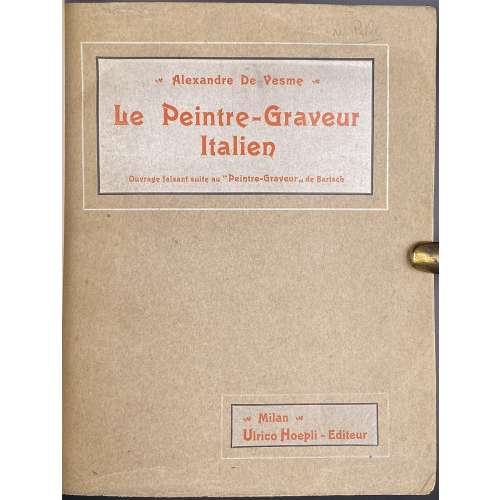 Description: 4to, 26 x 21 cm, hardcover ¾ brown percaline over marbled boards, gilt lettering to spine, marbled endpapers, publisher’s original wrappers preserved (bound-in), engraved bookplate “EX LIBRIS | Rodolfo …“ to verso of the 1st blank leaf. Printed in 1905 by Imprimerie Humbert Allegretti (Milan). Collation: 4to; front wrapper, π3 (blank, h.t., t.p.), 1-684, back wrapper; total 275 leaves within the wrappers. Pagination: [6] [1] 2-542 [2], total 550 pages. Contributors: Alessandro Baudi di Vesme [Alexandre de Vesme] (Italian, 1854 – 1923) Adam Bartsch (Austrian, 1757 – 1821) Ulrico Hoepli [Johannes Ulrich Höpli] (Swiss-Italian, 1846 – 1935) U. Hoepli (Milan)
Description: 4to, 26 x 21 cm, hardcover ¾ brown percaline over marbled boards, gilt lettering to spine, marbled endpapers, publisher’s original wrappers preserved (bound-in), engraved bookplate “EX LIBRIS | Rodolfo …“ to verso of the 1st blank leaf. Printed in 1905 by Imprimerie Humbert Allegretti (Milan). Collation: 4to; front wrapper, π3 (blank, h.t., t.p.), 1-684, back wrapper; total 275 leaves within the wrappers. Pagination: [6] [1] 2-542 [2], total 550 pages. Contributors: Alessandro Baudi di Vesme [Alexandre de Vesme] (Italian, 1854 – 1923) Adam Bartsch (Austrian, 1757 – 1821) Ulrico Hoepli [Johannes Ulrich Höpli] (Swiss-Italian, 1846 – 1935) U. Hoepli (Milan) -
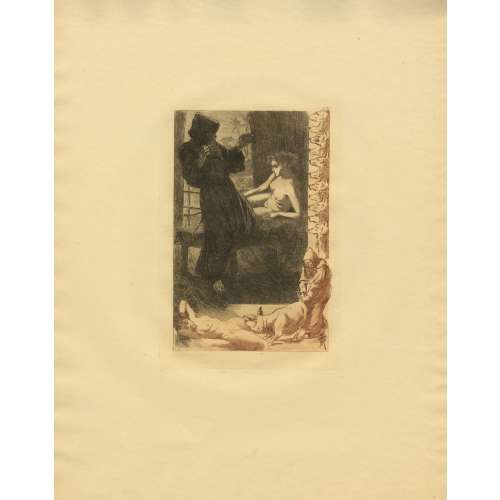 Set of 21 etchings by Martin van Maele for the English edition of ‘Thais’ by Anatole France published in London by Charles Carrington in 1901. Printed on vowe paper without a watermark in two colours with the black image and sepia historiated border. All etchings are inscribed with the artist's monogram; one of the etchings bears inscriptions ORGUEIL, LUXURE, DOUTE (mirror image). Dimensions: sheet: 317 x 250 mm; plate: 170 x 115 mm; image: 155 x 100 mm. Catalogue raisonné: S. A. Perry: № 64. Per Perry, the edition was printed in 500 copies on 'handmade paper watermarked 'Van Gelder'. Contributor: Martin van Maële [Martin, Maurice François Alfred] (French, 1863 – 1926)
Set of 21 etchings by Martin van Maele for the English edition of ‘Thais’ by Anatole France published in London by Charles Carrington in 1901. Printed on vowe paper without a watermark in two colours with the black image and sepia historiated border. All etchings are inscribed with the artist's monogram; one of the etchings bears inscriptions ORGUEIL, LUXURE, DOUTE (mirror image). Dimensions: sheet: 317 x 250 mm; plate: 170 x 115 mm; image: 155 x 100 mm. Catalogue raisonné: S. A. Perry: № 64. Per Perry, the edition was printed in 500 copies on 'handmade paper watermarked 'Van Gelder'. Contributor: Martin van Maële [Martin, Maurice François Alfred] (French, 1863 – 1926) -
![[Philip Graves]. The Truth About "The Protocols" : A Literary Forgery / From the Times of August 16, 17, and 18, 1921. — London: [The Times, 1921]. — pp.: [2 title, coloph.] 3-24.](https://varshavskycollection.com/wp-content/uploads/2021/02/LIB-2496.2020-a-scaled-500x500.jpeg) A contemporary reprint in publisher's wrappers, 22.8 x 14.4 cm, untrimmed, stapled, with title on the outer cover and similar to t.p.: The Truth About | "The Protocols" | A LITERARY FORGERY | From The Times of | August 16, 17, and 18, 1921 | LONDON: | PRINTING HOUSE SQUARE, E.C.4. | ONE SHILLING NET. || Pagination: [2] – t.p. / colophon, 3-24. Collation: [A]2 B10.
A contemporary reprint in publisher's wrappers, 22.8 x 14.4 cm, untrimmed, stapled, with title on the outer cover and similar to t.p.: The Truth About | "The Protocols" | A LITERARY FORGERY | From The Times of | August 16, 17, and 18, 1921 | LONDON: | PRINTING HOUSE SQUARE, E.C.4. | ONE SHILLING NET. || Pagination: [2] – t.p. / colophon, 3-24. Collation: [A]2 B10. -
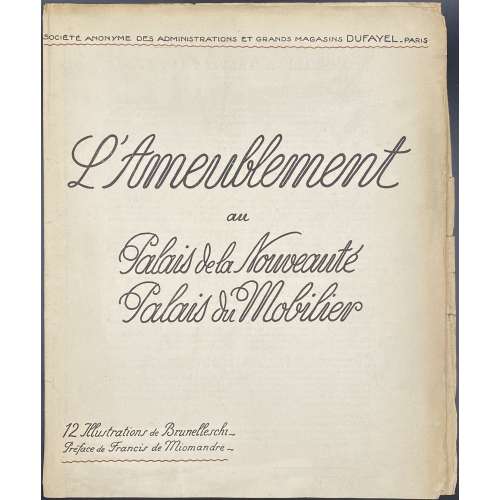 A set of 12 photomechanically reproduced illustrations after gouaches by Umberto Brunelleschi (Italian, 1879 – 1949), in colour; b/w photographs reproductions on verso, in a paper folder without the outer wrappers (b/w with birds, insects, and flowers). Text on the folder by French novelist Francis de Miomandre (French, 1880 – 1959); published by Grands Magasins Dufayel (1856 – 1930), a Parisian department store, run by Georges Dufayel (French, 1855 – 1916). Size: 29 x 24 cm. Images printed on cream paper within a beige frame, lettered above the frame in beige: "Societé Anonyme des Administrations et Grands Magasins DUFAYEL — Paris —", under the frame: "Palais de la Nouveauté ~ Palais du Mobilier | Entrée principale 7 Bould BARBES"; at the bottom of the frame lettered black on each image: Le Style Chinois, Le Style Empire, Le Style Japonais, Le Style Louis XIV, Le Style Louis XV, Le Style Louis XVI, Le Style Moderne (2), Le Style Moyen Age, Le Style Renaissance, Le Style Vénitien, Le Style Persian.
A set of 12 photomechanically reproduced illustrations after gouaches by Umberto Brunelleschi (Italian, 1879 – 1949), in colour; b/w photographs reproductions on verso, in a paper folder without the outer wrappers (b/w with birds, insects, and flowers). Text on the folder by French novelist Francis de Miomandre (French, 1880 – 1959); published by Grands Magasins Dufayel (1856 – 1930), a Parisian department store, run by Georges Dufayel (French, 1855 – 1916). Size: 29 x 24 cm. Images printed on cream paper within a beige frame, lettered above the frame in beige: "Societé Anonyme des Administrations et Grands Magasins DUFAYEL — Paris —", under the frame: "Palais de la Nouveauté ~ Palais du Mobilier | Entrée principale 7 Bould BARBES"; at the bottom of the frame lettered black on each image: Le Style Chinois, Le Style Empire, Le Style Japonais, Le Style Louis XIV, Le Style Louis XV, Le Style Louis XVI, Le Style Moderne (2), Le Style Moyen Age, Le Style Renaissance, Le Style Vénitien, Le Style Persian. -
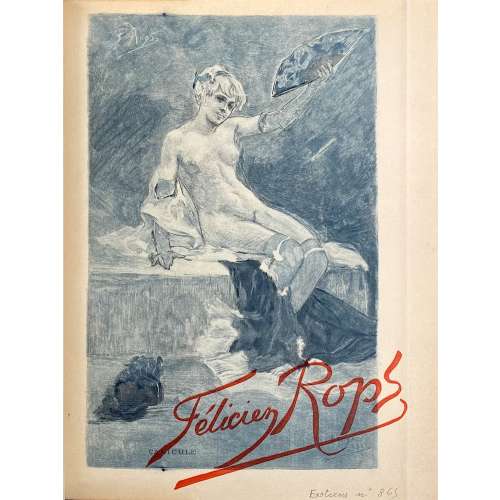 One volume in-4o, 26.5 x 21 x 4 cm, bound by Durvand (signed) in tan quarter morocco over marbled boards, spine with raised bands and gilt lettering, top margin gilt, marbled endpapers, publisher’s wrappers preserved; enriched with 39 original prints after Félicien Rops. Collation: 2 blanks, π5 (original front wrapper ‘Canicule’/blank, 2 blanks, h.t./justification, t.p/blank), 1-294 301 (paginated 1-233 [234]) χ1 (advert.) plus frontispiece (photographic seated portrait of Félicien Rops, collotype, artist unknown) and 39 leaves of bound-in original prints by various printers on different papers, with tissue guards; back wrapper and original spine, 2 blanks; loosely inset a marriage invitation for Dr Robert Fasquelle and Mlle Suzanne Luneau with a partial list of prints, incl. page numbers. Title-page (red and black): Études sur quelques Artistes originaux | — | FÉLICIEN ROPS | par | CAMILLE LEMONNIER | {fleuron} | PARIS | H. FLOURY, ÉDITEUR | 1, Boulevard des Capucines, 1 | – | 1908 || Limitation: 125 copies with two original plates «Canicule» and «Seule» numbered 1-125, of which 100 copies on Japon à la forme, 25 copies on papier de Chine; plus 50 copies on papier vélin with one coloured plate «Canicule», numbered 126-175, printed by Edmond Deman in Brussels. Our copy is on dense wove paper (vélin), without a number. Photographs here represent the original prints only. Camille Lemonnier (Belgian, 1844 – 1913) – author. Félicien Rops (Belgian, 1833 – 1898) – artist. Henri Floury (French, 1862 –1961) – publisher. Edmond Deman (Belgian, 1857–1918) – printer. Lucien Durvand (French, 1852 – 1924) – bookbinder.
One volume in-4o, 26.5 x 21 x 4 cm, bound by Durvand (signed) in tan quarter morocco over marbled boards, spine with raised bands and gilt lettering, top margin gilt, marbled endpapers, publisher’s wrappers preserved; enriched with 39 original prints after Félicien Rops. Collation: 2 blanks, π5 (original front wrapper ‘Canicule’/blank, 2 blanks, h.t./justification, t.p/blank), 1-294 301 (paginated 1-233 [234]) χ1 (advert.) plus frontispiece (photographic seated portrait of Félicien Rops, collotype, artist unknown) and 39 leaves of bound-in original prints by various printers on different papers, with tissue guards; back wrapper and original spine, 2 blanks; loosely inset a marriage invitation for Dr Robert Fasquelle and Mlle Suzanne Luneau with a partial list of prints, incl. page numbers. Title-page (red and black): Études sur quelques Artistes originaux | — | FÉLICIEN ROPS | par | CAMILLE LEMONNIER | {fleuron} | PARIS | H. FLOURY, ÉDITEUR | 1, Boulevard des Capucines, 1 | – | 1908 || Limitation: 125 copies with two original plates «Canicule» and «Seule» numbered 1-125, of which 100 copies on Japon à la forme, 25 copies on papier de Chine; plus 50 copies on papier vélin with one coloured plate «Canicule», numbered 126-175, printed by Edmond Deman in Brussels. Our copy is on dense wove paper (vélin), without a number. Photographs here represent the original prints only. Camille Lemonnier (Belgian, 1844 – 1913) – author. Félicien Rops (Belgian, 1833 – 1898) – artist. Henri Floury (French, 1862 –1961) – publisher. Edmond Deman (Belgian, 1857–1918) – printer. Lucien Durvand (French, 1852 – 1924) – bookbinder. -
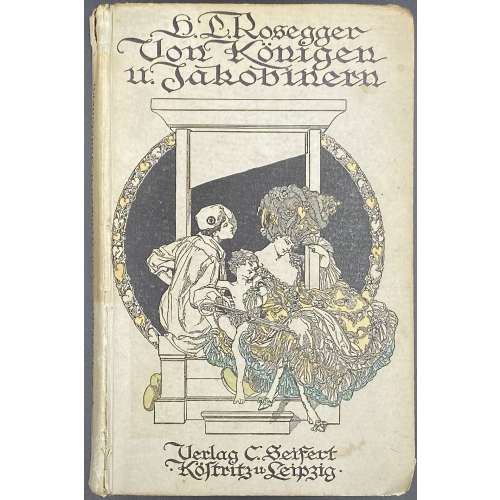 Cover (in blackletter): H. L. Rosegger. | Von Königen u. Jakobinern | {vignette by von Bayros} | Verlag C. Seifert | • Köstritz u Leipzig • || Title (blackletter): Von Königen | und Jakobinern | Von | Hans Ludwig Rosegger | mit vier Vollbildern und Buchschmuck | von Marquis F. von Bayros | {publisher’s device} | 1913 | C. Seifert Verlag, G.m.b.H. | Köstritz und Leipzig || Pagination: [2] – t.p. / blank, [2] – contents / blank, [1-3] 4-263 [264 vignette, colophon], 4 plates extraneous to collation, 2 vignettes. Collation: 8vo; 1-168 174. Binding: Hardcover, pictorial paper boards, lettering to spine, lettering and vignette by von Bayros to cover. Owner's inscription to ffl: "T. Lewe. März, 1919."
Cover (in blackletter): H. L. Rosegger. | Von Königen u. Jakobinern | {vignette by von Bayros} | Verlag C. Seifert | • Köstritz u Leipzig • || Title (blackletter): Von Königen | und Jakobinern | Von | Hans Ludwig Rosegger | mit vier Vollbildern und Buchschmuck | von Marquis F. von Bayros | {publisher’s device} | 1913 | C. Seifert Verlag, G.m.b.H. | Köstritz und Leipzig || Pagination: [2] – t.p. / blank, [2] – contents / blank, [1-3] 4-263 [264 vignette, colophon], 4 plates extraneous to collation, 2 vignettes. Collation: 8vo; 1-168 174. Binding: Hardcover, pictorial paper boards, lettering to spine, lettering and vignette by von Bayros to cover. Owner's inscription to ffl: "T. Lewe. März, 1919." -
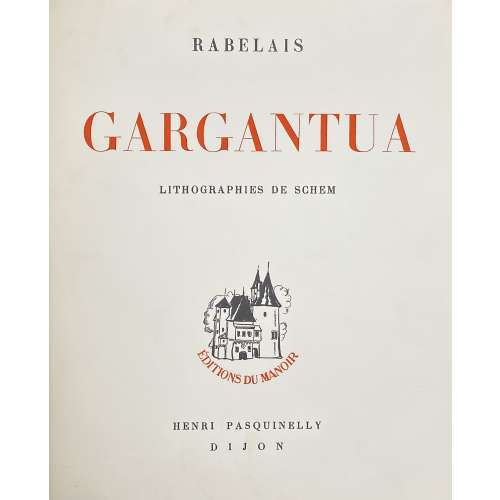 Description: One volume bound in green morocco, sunned spine with raised bands and gilt lettering, collated 8vo, 28.3 x 23 cm, original wrappers and spine preserved, top margin gilt; numerous in-text woodcuts, 30 full-page plates and one plate tipped-in. Front wrapper (red and black): RABELAIS | GARGANTUA | LITHOGRAPHIES DE SCHEM | {publisher’s device lettered in red “ÉDITIONS DU MANOIR”} | HENRI PASQUINELLY | DIJON || Half-title: LA VIE TRESHORRIFIQUE | DU | GRAND GARGANTUA | PERE DE PANTAGRUEL | JADIS COMPOSÉE | PAR MAISTRE ALCOFRIBAS | ABSTRACTEUR DE QUINTE ESSENCE | — | LIVRE PLEIN DE PANTAGRUELISME || Title-page (red and black): RABELAIS | GARGANTUA | LITHOGRAPHIES DE SCHEM | AVEC UNE PRÉFACE ET DES RÉSUMÉS EXPLICATIFS PAR | PIERRE HUGUENIN | UN GLOSSAIRE ET DES NOTES DE | LOUIS PERCEAU | {publisher’s device lettered in red “ÉDITIONS DU MANOIR”} | HENRI PASQUINELLY | DIJON || Collation: 2 blanks, front wrapper, [1] 2-118, spine, back wrapper, 2 blanks, total 88 leaves between the wrappers plus 30 plates incl. frontispiece, two of which are double-page, extraneous to collation with lettered tissue guards, and one cancelled plate with lettered tissue guard tipped-in. Pagination: [1-7] 8-171 [172] [2 colophon] [2 blank], total 176 pages, ils. Printed on February 20, 1937, at Imprimerie Darantière (Dijon), lithographs were printed by Desjobert (Paris). Limitation: The print run of 3,335 copies, of which 10 (№ I-X) on Japon Impérial, 300 copies (№ 1-300) on Vélin de Rives, 3000 copies (№ 301-3,300) on Bouffant Dauphinois, and 25 copies (A-Z ) on Vélin de Rives for collaborators. This is copy № 45 on Vélin de Rives, enriched with one cancelled plate (see image below).Collaborators: François Rabelais [Alcofribas Nasier] (French, c. 1494 – 1553) – author. Pierre Huguenin (French, 1874 – 1937) – author. Louis Perceau (French, 1883 – 1942) – author. Raoul Serres [Schem] (French, 1881– 1971) – artist. Éditions du manoir; Henri Pasquinelly [Pasquinelli] (French, 20th century) – publisher. Imprimerie Darantière (Dijon) – printer. Edmond Desjobert (French, 1888 – 1963); Edmond et Jacques Desjobert – lithography printer.
Description: One volume bound in green morocco, sunned spine with raised bands and gilt lettering, collated 8vo, 28.3 x 23 cm, original wrappers and spine preserved, top margin gilt; numerous in-text woodcuts, 30 full-page plates and one plate tipped-in. Front wrapper (red and black): RABELAIS | GARGANTUA | LITHOGRAPHIES DE SCHEM | {publisher’s device lettered in red “ÉDITIONS DU MANOIR”} | HENRI PASQUINELLY | DIJON || Half-title: LA VIE TRESHORRIFIQUE | DU | GRAND GARGANTUA | PERE DE PANTAGRUEL | JADIS COMPOSÉE | PAR MAISTRE ALCOFRIBAS | ABSTRACTEUR DE QUINTE ESSENCE | — | LIVRE PLEIN DE PANTAGRUELISME || Title-page (red and black): RABELAIS | GARGANTUA | LITHOGRAPHIES DE SCHEM | AVEC UNE PRÉFACE ET DES RÉSUMÉS EXPLICATIFS PAR | PIERRE HUGUENIN | UN GLOSSAIRE ET DES NOTES DE | LOUIS PERCEAU | {publisher’s device lettered in red “ÉDITIONS DU MANOIR”} | HENRI PASQUINELLY | DIJON || Collation: 2 blanks, front wrapper, [1] 2-118, spine, back wrapper, 2 blanks, total 88 leaves between the wrappers plus 30 plates incl. frontispiece, two of which are double-page, extraneous to collation with lettered tissue guards, and one cancelled plate with lettered tissue guard tipped-in. Pagination: [1-7] 8-171 [172] [2 colophon] [2 blank], total 176 pages, ils. Printed on February 20, 1937, at Imprimerie Darantière (Dijon), lithographs were printed by Desjobert (Paris). Limitation: The print run of 3,335 copies, of which 10 (№ I-X) on Japon Impérial, 300 copies (№ 1-300) on Vélin de Rives, 3000 copies (№ 301-3,300) on Bouffant Dauphinois, and 25 copies (A-Z ) on Vélin de Rives for collaborators. This is copy № 45 on Vélin de Rives, enriched with one cancelled plate (see image below).Collaborators: François Rabelais [Alcofribas Nasier] (French, c. 1494 – 1553) – author. Pierre Huguenin (French, 1874 – 1937) – author. Louis Perceau (French, 1883 – 1942) – author. Raoul Serres [Schem] (French, 1881– 1971) – artist. Éditions du manoir; Henri Pasquinelly [Pasquinelli] (French, 20th century) – publisher. Imprimerie Darantière (Dijon) – printer. Edmond Desjobert (French, 1888 – 1963); Edmond et Jacques Desjobert – lithography printer.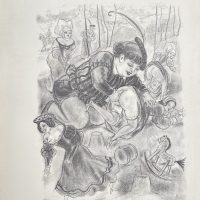
Ce petit paillard tousjours tastonnoyt ses gouvernantes cen dessus dessous, cen devant darriere.
-
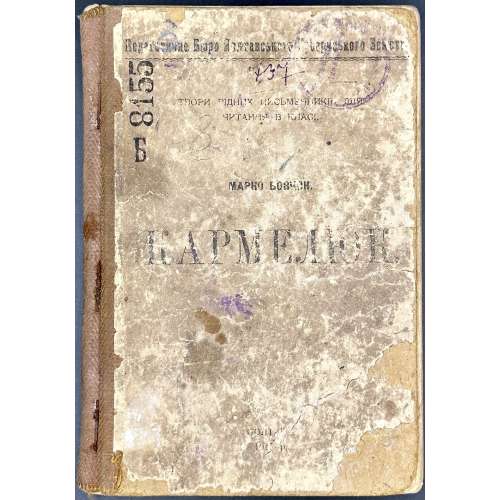 Owner’s quarter brown cloth, 18.2 x 12.5 cm, lettered paper over cardboard; text printed on tan paper, [1, 2] (t.p.), [i] ii-viii (intro.), [1] 4-48 (text); total 28 leaves; blue and red crayon marks to text; boards and pages with blue ink stamps and inscriptions. Front board: Педагогичне Бюро Полтавського Губернського Земства. | ТВОРИ РІДНИХ ПИСЬМЕННИКІВ ДЛЯ | ЧИТАННЯ В КЛАСІ.| МАРКО ВОВЧОК. | КАРМЕЛЮК. | ПОЛТАВА. | 1917 р. || Back board: Серія складається з творів: | Квітки, Вовчка, Шевченка, Куліша, | Руданського, Левицького І, Мирного, | Франка, Грінченка, Коцюбинського. | Полтава, друкарня Амчиславського. || Title-page: Педагогичне Бюро Полтавського Губернського Земства. | МАРКО ВОВЧОК. | КАРМЕЛЮК. | ПОЛТАВА. | 1917 р. || Contributors: Марко Вовчок [Marko Vovchok; Марія Олександрівна Вілінська] (Ukrainian, 1833 – 1907) – author. Other variants: Markowovzok and Marko Vovtchok. Амчиславский, М. Г. (Полтава, ул. Пушкина, 40) – printer.
Owner’s quarter brown cloth, 18.2 x 12.5 cm, lettered paper over cardboard; text printed on tan paper, [1, 2] (t.p.), [i] ii-viii (intro.), [1] 4-48 (text); total 28 leaves; blue and red crayon marks to text; boards and pages with blue ink stamps and inscriptions. Front board: Педагогичне Бюро Полтавського Губернського Земства. | ТВОРИ РІДНИХ ПИСЬМЕННИКІВ ДЛЯ | ЧИТАННЯ В КЛАСІ.| МАРКО ВОВЧОК. | КАРМЕЛЮК. | ПОЛТАВА. | 1917 р. || Back board: Серія складається з творів: | Квітки, Вовчка, Шевченка, Куліша, | Руданського, Левицького І, Мирного, | Франка, Грінченка, Коцюбинського. | Полтава, друкарня Амчиславського. || Title-page: Педагогичне Бюро Полтавського Губернського Земства. | МАРКО ВОВЧОК. | КАРМЕЛЮК. | ПОЛТАВА. | 1917 р. || Contributors: Марко Вовчок [Marko Vovchok; Марія Олександрівна Вілінська] (Ukrainian, 1833 – 1907) – author. Other variants: Markowovzok and Marko Vovtchok. Амчиславский, М. Г. (Полтава, ул. Пушкина, 40) – printer. -
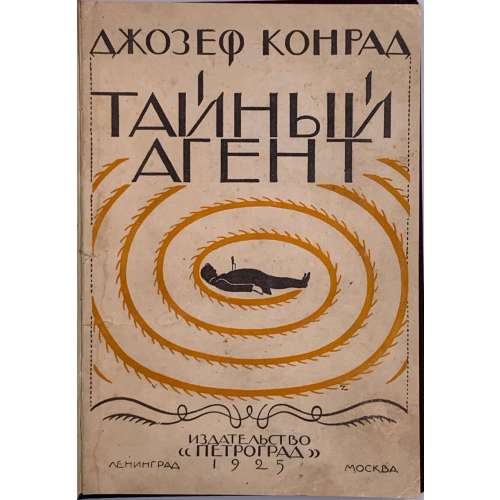 20 x 14.5 cm, owner’s burgundy buckram, upper original pictorial wrapper preserved, in black and yellow. Title: ДЖОЗЕФ КОНРАД | ТАЙНЫЙ АГЕНТ | (The secret agent) | Перевод с английского | М. МАТВЕЕВОЙ | под редакцией | В. А. АЗОВА | {device} | Издательство “ПЕТРОГРАД” | ЛЕНИНГРАД — МОСКВА | 1925. Pagination: ffl, [2] orig. wrapper/blank, [1, 2] t.p./imprint, 3-245 [3 advert.] Collation: 8vo; [1]8 2-158 164. Print run: 5.000 copies. Редактор перевода: В. А. Азов Contributors: Joseph Conrad (Polish-British, 1857 – 1924) – author. Владимир Александрович Ашкинази [Азов] (Russian-French, 1873 – 1941) – translator/editor. Марианна Николаевна Матвеева (Russian, 20th century) – translator. Original title: [LIB-2762.2021] Joseph Conrad. The secret agent: a simple tale. — London: Methuen & Co., [1907]; [LIB-3213.2023] Joseph Conrad. The secret agent: A drama in three acts. — London, T. Werner Laurie., 1923.
20 x 14.5 cm, owner’s burgundy buckram, upper original pictorial wrapper preserved, in black and yellow. Title: ДЖОЗЕФ КОНРАД | ТАЙНЫЙ АГЕНТ | (The secret agent) | Перевод с английского | М. МАТВЕЕВОЙ | под редакцией | В. А. АЗОВА | {device} | Издательство “ПЕТРОГРАД” | ЛЕНИНГРАД — МОСКВА | 1925. Pagination: ffl, [2] orig. wrapper/blank, [1, 2] t.p./imprint, 3-245 [3 advert.] Collation: 8vo; [1]8 2-158 164. Print run: 5.000 copies. Редактор перевода: В. А. Азов Contributors: Joseph Conrad (Polish-British, 1857 – 1924) – author. Владимир Александрович Ашкинази [Азов] (Russian-French, 1873 – 1941) – translator/editor. Марианна Николаевна Матвеева (Russian, 20th century) – translator. Original title: [LIB-2762.2021] Joseph Conrad. The secret agent: a simple tale. — London: Methuen & Co., [1907]; [LIB-3213.2023] Joseph Conrad. The secret agent: A drama in three acts. — London, T. Werner Laurie., 1923. -
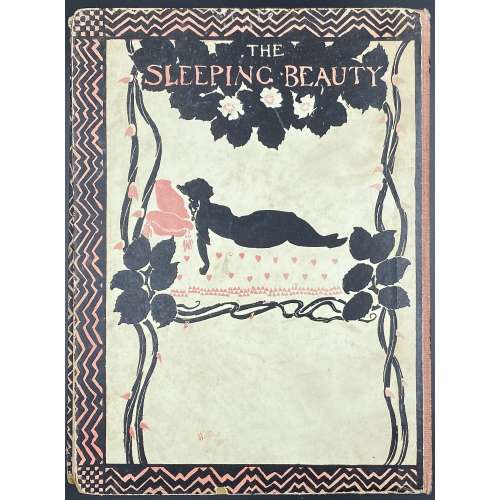 Title: THE SLEEPING | BEAUTY | TOLD BY C S EVANS | AND ILLUSTRATED BY | ARTHUR RACKHAM | LONDON WILLIAM HEINEMANN | PHILADELPHIA J B LIPPINCOTT Co || T.p. verso: LONDON WILLIAM HEINEMANN, 1920. Pagination: [1, 2] – h.t. / advert., [3, 4] – “WH” publisher’s device / frontis., [5, 6] – pictorial t.p. / publisher, year, [7, 8] – silhouette girls / Briar rose w/pasted offset ill., [9] 10-110 [2] – imprint / blank]. Collation: 8vo; B-G8, 3 double-leaf 3-colour woodcut illustrations extraneous to collation, in-text woodcuts. Illustrations: 25 full-page silhouettes, comprising 9 in colour (frontispiece and 4 double plates)--and 16 in black (including 4 double illustrations); one mounted coloured plate; silhouette head- and tailpieces and other silhouettes throughout the text, in black. Binding: Quarter cloth with black lettering, pictorial boards, pictorial endpapers. Size: 26 x 19.5. 1st edition. Inscription to h.t.: "To Dear Julia, Xmas 1947."
Title: THE SLEEPING | BEAUTY | TOLD BY C S EVANS | AND ILLUSTRATED BY | ARTHUR RACKHAM | LONDON WILLIAM HEINEMANN | PHILADELPHIA J B LIPPINCOTT Co || T.p. verso: LONDON WILLIAM HEINEMANN, 1920. Pagination: [1, 2] – h.t. / advert., [3, 4] – “WH” publisher’s device / frontis., [5, 6] – pictorial t.p. / publisher, year, [7, 8] – silhouette girls / Briar rose w/pasted offset ill., [9] 10-110 [2] – imprint / blank]. Collation: 8vo; B-G8, 3 double-leaf 3-colour woodcut illustrations extraneous to collation, in-text woodcuts. Illustrations: 25 full-page silhouettes, comprising 9 in colour (frontispiece and 4 double plates)--and 16 in black (including 4 double illustrations); one mounted coloured plate; silhouette head- and tailpieces and other silhouettes throughout the text, in black. Binding: Quarter cloth with black lettering, pictorial boards, pictorial endpapers. Size: 26 x 19.5. 1st edition. Inscription to h.t.: "To Dear Julia, Xmas 1947." -
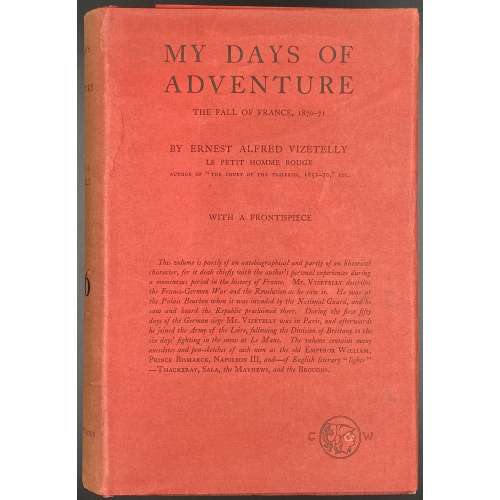 Description: Hardcover volume bound in red cloth with black lettering to front cover and spine, in a red dustjacket with black lettered, bookplate to front pastedown “ from the library of | DAVID. D. LEVINE | Militaria” in triple fillet frame, bookseller’s label to front fep “CHAS. E. LAURIAT CO. | IMPORTERS & BOOKSELLERS | 385 Wash’n St. Boston”. Title-page in red and black: MY DAYS OF ADVENTURE | THE FALL OF FRANCE, 1870-71 | BY ERNEST ALFRED VIZETELLY | LE PETIT HOMME ROUGE | AUTHOR OF “THE COURT OF THE TUILERIES 1852-70” ETC. | {publisher’s device} | WITH A FRONTISPIECE | LONDON | CHATTO & WINDUS | 1914 || Pagination: [2] advert., [i-vii] viii-xi [xii] [2] contents/blank, [1] 2-337 [338] [2], 340 pages total plus photo frontis. Collation: [A8] B-Y8 Z2, 170 leaves total plus one leaf of plates. Provenance: David D. Levine Contributors: Ernest Alfred Vizetelly (British, 1853 – 1922) – author. Charles E. Lauriat Company, Booksellers and Importers, Boston, Massachusetts. Charles Emelius Lauriat, Jr. (American, 1874 – 1937) – collector of rare books and prints Chatto & Windus (London) – publisher. David Daniel Levine (Australian, 1944 – 2020) – Australian judge and book collector
Description: Hardcover volume bound in red cloth with black lettering to front cover and spine, in a red dustjacket with black lettered, bookplate to front pastedown “ from the library of | DAVID. D. LEVINE | Militaria” in triple fillet frame, bookseller’s label to front fep “CHAS. E. LAURIAT CO. | IMPORTERS & BOOKSELLERS | 385 Wash’n St. Boston”. Title-page in red and black: MY DAYS OF ADVENTURE | THE FALL OF FRANCE, 1870-71 | BY ERNEST ALFRED VIZETELLY | LE PETIT HOMME ROUGE | AUTHOR OF “THE COURT OF THE TUILERIES 1852-70” ETC. | {publisher’s device} | WITH A FRONTISPIECE | LONDON | CHATTO & WINDUS | 1914 || Pagination: [2] advert., [i-vii] viii-xi [xii] [2] contents/blank, [1] 2-337 [338] [2], 340 pages total plus photo frontis. Collation: [A8] B-Y8 Z2, 170 leaves total plus one leaf of plates. Provenance: David D. Levine Contributors: Ernest Alfred Vizetelly (British, 1853 – 1922) – author. Charles E. Lauriat Company, Booksellers and Importers, Boston, Massachusetts. Charles Emelius Lauriat, Jr. (American, 1874 – 1937) – collector of rare books and prints Chatto & Windus (London) – publisher. David Daniel Levine (Australian, 1944 – 2020) – Australian judge and book collector -
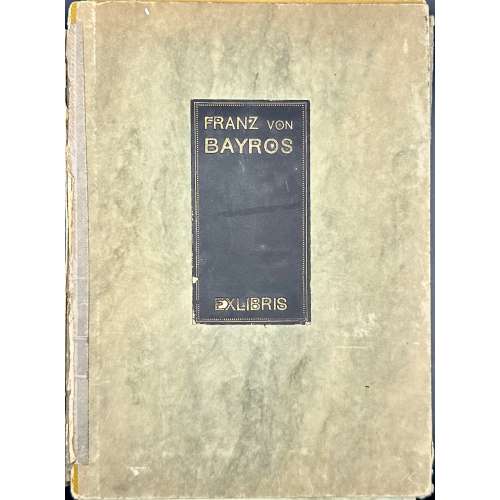 A set of 49 prints, heliogravures and etchings, tipped-in on 285 x 257 mm grey cards, in a green marbled folder with a gilt-lettered black label to the front. No publisher, no place, no year (s.l., s.n., s.d.), printed in circa 1910.
A set of 49 prints, heliogravures and etchings, tipped-in on 285 x 257 mm grey cards, in a green marbled folder with a gilt-lettered black label to the front. No publisher, no place, no year (s.l., s.n., s.d.), printed in circa 1910.- Vlastimil Blažek (Czech, 1878 – 1950): heliogravure, sheet 180 x 137 mm, plate 152 x 114 mm; laid paper, black sepia ink; unsigned.
- Ex libris Gerhard Wunderlich (architect in Dresden): heliogravure, sheet 205 x 150 mm, plate 158 x 115 mm; wove paper, brown sepia ink; inscription: heliogravure, sheet 180 x 137 mm, plate 152 x 114 mm; laid paper, sepia ink; inscription to top “Es ist alles so eng”; signed “F (backwards). Bayros”.
- Ex libris William Lipka: heliogravure, sheet 140 x 125 mm, plate 112 x 98 mm; laid paper, black sepia ink; signature hardly legible.
- Nikolaus Schindler (amateur photographer in Vienna): heliogravure, sheet 142 x 150 mm, plate 110 x 117 mm; laid paper, black sepia ink; unsigned.
- Sussy de Coiquard: heliogravure, sheet 160 x 140 mm, plate 128 x 110 mm; laid paper, black sepia ink; unsigned.
- Illegible, looks like “Vielluer Febréy”: heliogravure, sheet 120 x 109 mm, plate 93 x 85 mm; laid paper, black, sepia ink; signed “F (backwards). Bayros:”.
- Ex libris Erich Liebermann-Rosswiese (Greman-Jewish, 1886 – 1942): heliogravure, sheet 180 x 139 mm, plate 118 x 88 mm; wove paper, black sepia ink; unsigned.
- Ex libris Dr. phil. Rudolf Ludwig: before letters, heliogravure, sheet 150 x 132 mm, plate 120 x 110 mm; laid paper, black sepia ink; unsigned. See [LIB-3258.2023] John Cleland. Die Memoiren der Fanny Hill. — Paphos [i.e. Vienna]: C. W. Stern, 1906.
- Unidentified: before letters, heliogravure, sheet 150 x 115 mm, plate 113 x 88 mm; laid paper, black sepia ink; signed “F. Bayros” in the manuscript. Circumstantial evidence tells that this bookplate belongs to someone A.W.(Artur Wolf). See №22.
- Lulu. Monachia. Gest. v. Ritter Dialekt und Junker Erich: heliogravure, sheet 204 x 152 mm, plate 160 x 118 mm; wove paper, black sepia ink; unsigned. See №20.
- Kellner Jstván: (István): heliogravure, sheet 118 x 100 mm, plate 85 x 70 mm; laid paper, black sepia ink; signed “Franz Bayros” in the script (hardly legible).
- Adyton: heliogravure, sheet 170 x 130 mm, plate 113 x 85 mm; wove paper, black, sepia ink; signed “F (backwards). Bayros”.
- 13.Ex libris George Arthur Buhl (American, 1883 – 1959): heliogravure, sheet 166 x 140 mm, plate 120 x 92 mm; wove paper, black sepia ink; inscription “!I will! | !And I can!”; bust inscribed “T. Carlyle”; signed “F (backwards). Bayros” (hardly legible).
- Ex-Libris Heinrich und Lise Fuhrmann: heliogravure, sheet 165 x 149 mm, plate 120 x 103 mm; wove paper, black sepia ink; signed “F (backward). Bayros”; inscription “So schaff ich am sausenden Webstuhl der Zeit und wirke der Gottheit lebendiges Kleid” (from ‘Faust’ by Goethe).
- Ex libris Gerhard Wunderlich (architect in Dresden): heliogravure, sheet 165 x 137 mm, plate 135 x 105 mm; laid paper, black, sepia ink; signed “F (backwards). Bayros”.
- Ex Libris Walther u. Amelia Fahrenhorst; Walter Fahrenhorst (German, 1871 – 1938): heliogravure, sheet 165 x 140 mm, plate 128 x 95 mm; wove paper, black sepia ink; signed “F. Bayros” in the manuscript. The inscription behind the strings: NITOR (lat. beauty, glamour).
- Ex Libris Margot Lewknecht; heliogravure, sheet 145 x 140 mm, plate 128 x 118 mm; laid paper, black sepia ink; signed “F. Bayros”.
- Ex Libris Walther Heinisch (publisher in Carlsbad); heliogravure, sheet 185 x 145 mm, plate 140 x 110 mm; wove paper, sanguine; male bust with an inscription to the base: “Arnold Boeklin” / Arnold Böcklin (Swiss, 1827 – 1901); inscription: “mit gêru scal man geba infâhan” – a line from Hildebrandslied, the earliest poetic text in German. Unsigned.
- Bookplate with music score GGDBGC; heliogravure, sheet 125 x 135 mm, plate 100 x 110 mm, with monogram «HCJ»; laid paper, brown sepia ink; signed “F. Bayros”.
- Bookplate with inscription: Lulu aus Praga | Gest v. Ritter Dialekt / Monachia / Monachia / und Junker Erich; heliogravure, sheet 182 x 147 mm, plate 160 x 120 mm, image 122 x 105 mm; wove paper, bluish-black sepia ink; unsigned. See №10.
- Bookplate, no inscription; heliogravure, laid paper, sepia ink, sheet 148 x 127 mm, image 84 x 79 mm; signed F. Bayros in the manuscript beneath the image.
- Ex libris Artur Wolf: heliogravure, laid paper, sepia ink, sheet 170 x 150 mm, image 120 x 105 mm; signed F. Bayros in the manuscript to the frame of the image. See №9.
- Ex Libris E. K. Weigl: heliogravure, laid paper, sepia ink, sheet 139 x 121 mm, plate 112 x 97 mm; unsigned; inscription above male portrait: “LEONARDO”.
- Ex libris Dr. A. Bergmann: heliogravure, wove paper, sepia ink; sheet 180 x 140 mm, plate 130 x 105 mm; signed F. Bayros in the manuscript.
- Grete Cäcilie (monogram “PS”): heliogravure, laid paper, sepia ink, sheet 161 x 130 mm, plate 128 x 103 mm, signature illegible.
- Emma Steigleder: heliogravure, laid paper, black ink, sheet 181 x 141 mm, plate 158 x 117 mm, signed F. Bayros in the manuscript. Inscription “Si vis amari, ama! Seneca” [If you want to be loved, love] to the attic of the arch.
- Bruno Fischer: heliogravure, laid paper, sepia ink, sheet 186 x 145 mm, plate 155 x 116 mm, signed “F (backward). Bayros”. Inscription to bottom “Gehl Weck’ ihn nicht auf seien wir froh dass er einmal schläft!”
- Harnasch: heliogravure, wove paper, sepia ink; unsigned; sheet 140 x 132 mm, plate 100 x 85 mm; unsigned.
- Eduard Klampfl: heliogravure, laid paper, sepia ink, sheet 165 x 145 mm, plate 135 x 110 mm, signed “F (backwards). Bayros”; portrait bust of the composer Richard Wagner (German, 1813 –1883).
- Jorge Monsalvatje: heliogravure, wove paper, sepia ink; sheet 189 x 160 mm, plate 150 x 115 mm; signed F. Bayros in the manuscript.
- E. K. W.: wove paper, sepia ink; sheet 150 x 120 mm; signed “Bayros”.
- Unidentified bookplate: wove paper, sepia ink; sheet 150 x 120 mm; signed “F. Bayros 09” in the manuscript.
- Ex-Libris Helene and Emil Lemberger: heliogravure (or soft ground etching), laid paper, sepia ink, sheet 180 x 163 mm, plate 150 x 130 mm, signed “F. Bayros” in the manuscript.
- M. Z.: wove paper, sepia ink; sheet 130 x 170 mm, plate 90 x 120 mm; signed “F (backwards) Bayros”.
- Ex libris Frankl Frigyes Vilmos: heliogravure (or soft ground etching), laid paper, sepia ink, sheet 140 x 148 mm, unsigned. Frigyes Frankl, born in Tejfalu, Szlovákia, died in 1943.
- Ex libris Anton Bürck: heliogravure, wove paper, sepia ink; sheet 170 x 137 mm, plate 123 x 104 mm; unsigned. Anton Burck (German,1881 – 1951) of Palatinate, Bavaria.
- Aus den büchern A. W.: heliogravure, laid paper, sepia ink, sheet 152 x 136 mm, plate 120 x 105 mm, signed “F. Bayros” in the manuscript.
- Ex libris Hans Hickl: heliogravure, laid paper, sepia ink, sheet 150 x 125 mm, plate 115 x 95 mm, signed “Ω”.
- Ex libris Karl Wehle: soft ground etching, laid paper, brown sepia ink, sheet 107 x 90 mm, plate 80 x 65 mm, inscription “Gut!” in the centre; unsigned. Karl Wehle (Austrian, 1901 – 1933)
- Ex libris Dr. Paul Berger: etching, laid paper, black ink, sheet 140 x 115 mm, plate 115 x 85 mm, signed “F (backwards). Bayros”.
- Unidentified bookplate: etching, laid paper, black ink, sheet 145 x 115 mm, plate 85 x 70 mm, unsigned.
- Ex Bibliotheca Erotica Carl Georg von Maassen: soft ground etching, india paper, black ink, sheet 76 x 78 mm, signed “FB”.
- Ex Bibliotheca Erotica Carl Georg von Maassen: soft ground etching, india paper, black ink, sheet 79 x 79 mm, signed “F. von Bayros”.
- Paul Mixa: soft ground etching, laid paper, sanguine ink, sheet 122 x 111 mm, plate 90 x 85 mm, inscription: “Gerne hör’ich wenn du singest und ich horche wenn du schweigest” [I like to hear when you sing and I listen when you are silent].
- Ex libris Drs Q. M. Vyskocil.: etching, laid paper, sanguine ink, sheet 141 x 115 mm, plate 115 x 75 mm, inscription: “MIT REINEN HAENDEN” [with pure hands], signed “F. Bayros” in the manuscript.
- Ex libris Andrée Bearn de Riquer: soft ground etching, laid paper, sanguine ink, sheet 136 x 88 mm, plate 100 x 62 mm, signed “F (backwards). Bayros”. Andrée Béarn [Marguerite Laborde] (French, 1880 – 1973), spouse of Alexandre de Riquer (Catalan, 1856 – 1920).
- Ex musicis Drs Blažek VL: etching, wove paper, sanguine ink, sheet 141 x 116 mm, plate 115 x 90 mm, inscription: “MIT REINEN HAENDEN” [with pure hands], signed “F. Bayros” in the manuscript. See Vlastimil Blažek (Czech, 1878 – 1950) № 1 in this series.
- Ex libris Paul Lindenberg: etching, wove paper, sanguine ink, sheet 130 x 114 mm, plate 95 x 90 mm, image 80 x 72 mm, inscription: “ad pios usus” (for pious uses); signed with monogram “F (backwards). B”.
- Unidentified bookplate: heliogravure, laid paper, sanguine ink, sheet 150 x 131 mm, plate 120 x 100 mm, signed “F. Bayros” in the manuscript.
-
![Adelbert von Chamisso. Peter Schlemihls wundersame Geschichte. – Leipzig: Im Insel-Verlag, [1916 or 1923 or 1940] (Series: Insel-Bücherei, Nr. 194). – pp.: ff [1 t.p., 2 blank] 3-79 [80] bf., with 4 etchings [instead of woodcuts] by Adolf Schrödter [1838].](https://varshavskycollection.com/wp-content/uploads/2021/02/LIB-2497.2020-a-scaled-500x500.jpeg) Title (Gothic typeset): Peter Schlemihls | wundersame Geschichte | Mitgeteilt | von | Adelbert von Chamisso | {publisher’s device} | — | Im Insel-Verlag zu Leipzig || Series: Insel-Bücherei, Nr. 194. Pagination: 8vo; [1, 2] 3-79 [80]; 4 photomechanical reproductions of woodcuts by Adolf Schrödter [1838] within collation. Binding: 18.5 x 12.5 cm, hardcover, original patterned paper over cardboard, title label in yellow and black pasted to cover, label to spine. According to Herbert Kästner Die Insel-Bücherei: Bibliographie, 1912 - 1999: 4 illustrations by Adolf Schrödter, produced for 1838 edition as wood engravings here reproduced by photogravure. There were four print runs of this edition: 1916: 1.-10. Tsd; 1923: 35. Tsd; 1940: 55. Tsd. There is currently no way to tell which one is this. Contributors: Chamisso, Adelbert von (German, 1781–1838) – author. Schrödter, Adolf (German, 1805 – 1875) – artist.
Title (Gothic typeset): Peter Schlemihls | wundersame Geschichte | Mitgeteilt | von | Adelbert von Chamisso | {publisher’s device} | — | Im Insel-Verlag zu Leipzig || Series: Insel-Bücherei, Nr. 194. Pagination: 8vo; [1, 2] 3-79 [80]; 4 photomechanical reproductions of woodcuts by Adolf Schrödter [1838] within collation. Binding: 18.5 x 12.5 cm, hardcover, original patterned paper over cardboard, title label in yellow and black pasted to cover, label to spine. According to Herbert Kästner Die Insel-Bücherei: Bibliographie, 1912 - 1999: 4 illustrations by Adolf Schrödter, produced for 1838 edition as wood engravings here reproduced by photogravure. There were four print runs of this edition: 1916: 1.-10. Tsd; 1923: 35. Tsd; 1940: 55. Tsd. There is currently no way to tell which one is this. Contributors: Chamisso, Adelbert von (German, 1781–1838) – author. Schrödter, Adolf (German, 1805 – 1875) – artist. -
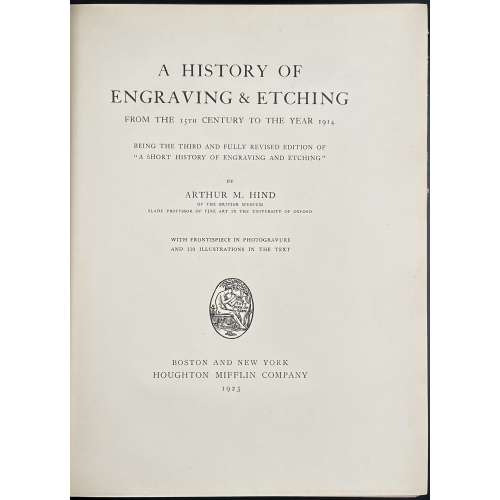 Title: A HISTORY OF | ENGRAVING & ETCHING | FROM THE 15TH CENTURY TO THE YEAR 1914 | BEING THE THIRD AND FULLY REVISED EDITION OF | “A SHORT HISTORY OF ENGRAVING AND ETCHING” | BY | ARTHUR M. HIND | OF THE BRITISH MUSEUM | SLADE PROFESSOR OF FINE ART IN THE UNIVERSITY OF OXFORD | WITH FRONTISPIECE IN PHOTOGRAVURE | AND 110 ILLUSTRATIONS IN THE TEXT | {publisher’s device} | BOSTON AND NEW YORK | HOUGHTON MIFFLIN COMPANY | 1923 || Pagination: [i-iv] v-xiii. [2] – blank / abbrev., [2] 3-487 [488], frontis. w/tissue guard, ills.; Appendices: I. Classified list of engravers (p. 343-392); II. General bibliography (p. 393-419); III. Index of engravers and individual bibliography (p. 420-487). Collation: π10 B-2H8 2I4, frontispiece (extr.), 110 in-text illustrations. Binding: 25.8 x 20 cm, crimson cloth, blind triple-fillet to top and bottom of the front board, same in gilt to spine, gilt lettering to spine, top edge gilt, fore-edge untrimmed. Contributors: Arthur Mayger Hind (British, 1880 – 1957) – author. Houghton Mifflin Company (Boston, 1864) – publisher. R & R. Clark, Ltd. (Edinburgh, 1846) – printer. Note: It is marked as the 3rd edition of A short history of engraving and etching. Indeed, A short history of engraving & etching for the use of collectors and students with full bibliography, classified list and index of engravers was published by Constable in London and Houghton Mifflin Co. in Boston, in 1908 and then in 1911. However, it is hard to consider an almost completely new book "a 3rd edition".
Title: A HISTORY OF | ENGRAVING & ETCHING | FROM THE 15TH CENTURY TO THE YEAR 1914 | BEING THE THIRD AND FULLY REVISED EDITION OF | “A SHORT HISTORY OF ENGRAVING AND ETCHING” | BY | ARTHUR M. HIND | OF THE BRITISH MUSEUM | SLADE PROFESSOR OF FINE ART IN THE UNIVERSITY OF OXFORD | WITH FRONTISPIECE IN PHOTOGRAVURE | AND 110 ILLUSTRATIONS IN THE TEXT | {publisher’s device} | BOSTON AND NEW YORK | HOUGHTON MIFFLIN COMPANY | 1923 || Pagination: [i-iv] v-xiii. [2] – blank / abbrev., [2] 3-487 [488], frontis. w/tissue guard, ills.; Appendices: I. Classified list of engravers (p. 343-392); II. General bibliography (p. 393-419); III. Index of engravers and individual bibliography (p. 420-487). Collation: π10 B-2H8 2I4, frontispiece (extr.), 110 in-text illustrations. Binding: 25.8 x 20 cm, crimson cloth, blind triple-fillet to top and bottom of the front board, same in gilt to spine, gilt lettering to spine, top edge gilt, fore-edge untrimmed. Contributors: Arthur Mayger Hind (British, 1880 – 1957) – author. Houghton Mifflin Company (Boston, 1864) – publisher. R & R. Clark, Ltd. (Edinburgh, 1846) – printer. Note: It is marked as the 3rd edition of A short history of engraving and etching. Indeed, A short history of engraving & etching for the use of collectors and students with full bibliography, classified list and index of engravers was published by Constable in London and Houghton Mifflin Co. in Boston, in 1908 and then in 1911. However, it is hard to consider an almost completely new book "a 3rd edition". -
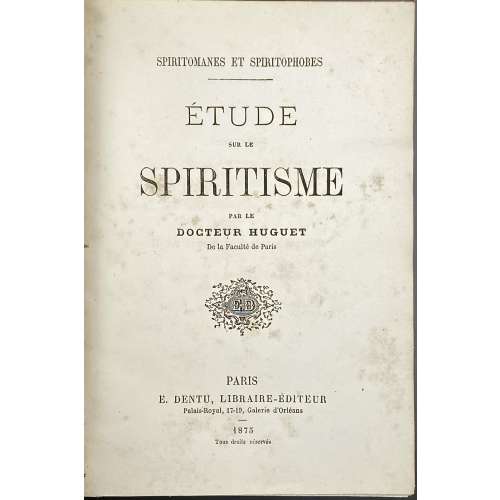 Hardcover volume 20 x 14 cm, bound in burgundy half faux chagrin over brown faux chagrin boards, gilt lettering to spine, marbled endpapers, all margins sprinkled blue. Convolute: 1) SPIRITOMANES ET SPIRITOPHOBES |— | ÉTUDE | SUR LE | SPIRITISME | PAR LE | DOCTEUR HUGUET | De la Faculté de Paris | {« ED » publsiher’s device} | PARIS | E. DENTU, LIBRAIRE-ÉDUTEUR | Palais-Royal, 17-19, Galerie d’Orléans | – | 1875 | Tous droits réservés ||; pp. [1-7] 8-48, with Dr Huguet signature to h.t. verso. Contents: Introduction. I. Le procès du 16 juin 1875; MM. Firman, Buguet, Leymarie. II. Le Spiritisme dans ses rapports avec le dogme, l’histoire, la science. Conclusion. 2) Same, pp. [1-7] 8-48, with Dr Huguet signature to h.t. verso. 3) FÉDÉRATION SPIRITE BELGE | — | Étude critique | DU LIVRE INTITULÉ | L'Hypnotisme | et le Spiritisme | du Docteur Joseph LAPPONI | Médecin de L. L. S. S. LÉON XIII et PIE X. | * | CONFÉRENCE | PAR | J. FRAIKIN | Président de la Fédération Spirite de Liége, | Vice-Président de la Fédération Spirite Belge. | * | Imp. Emile Dumon | Rue Haute-Marexhe, 27, Herstal-Liége. ||; pp. [1-3] 4-50 [51] errata/blank. 4) BUREAU PERMANENT D’ÉTUDE | DES | PHÉNOMÈNES SPIRITES | ANVERS | * | Cours De Doctrine Spirite | — | Imprimerie et Publicité « LA GÉNÉRALE » (SOC. AN.) Anvers. ||; 6 leaves, pagination trimmed out with partly visible numbers 13 and 18 ; includes Deuxième leçon « Du passage de la vie… », t.p., 7 pp. of text, last three pages blank. 5) LA PSYCHOLOGIE EXPERIMENTALE || Manifeste adresse par le « Syndicat de la Presse spiritualiste de France » | au Congres spiritualiste de Londres (Juin 1898); pp. [1] 2-31 [32]. Contents: I. Prolégomènes. II. Télépathie. III. Médiumnité. Conclusion. 6) LE FLUIDE HUMAIN | Son existence/ | Ses lois * Ses propriétés | — | CONFÉRENCE | DONNÉE PAR LE | Sous-Lieutenant DE BACKERE | — ||; pp. [1-3] 4-28. Contributors: Hilarion Huguet (French, ? – ?) Alfred-Henri Firman (American, ? – ?) Édouard Isidore Buguet (1840 – 1901) Pierre-Gaëtan Leymarie (1827 – 1901) Giuseppe Lapponi (Italian, 1851 – 1906) Jacques Fraikin (Belgian, ? – ?) Franz de Backere (Belgian, ? – ?)
Hardcover volume 20 x 14 cm, bound in burgundy half faux chagrin over brown faux chagrin boards, gilt lettering to spine, marbled endpapers, all margins sprinkled blue. Convolute: 1) SPIRITOMANES ET SPIRITOPHOBES |— | ÉTUDE | SUR LE | SPIRITISME | PAR LE | DOCTEUR HUGUET | De la Faculté de Paris | {« ED » publsiher’s device} | PARIS | E. DENTU, LIBRAIRE-ÉDUTEUR | Palais-Royal, 17-19, Galerie d’Orléans | – | 1875 | Tous droits réservés ||; pp. [1-7] 8-48, with Dr Huguet signature to h.t. verso. Contents: Introduction. I. Le procès du 16 juin 1875; MM. Firman, Buguet, Leymarie. II. Le Spiritisme dans ses rapports avec le dogme, l’histoire, la science. Conclusion. 2) Same, pp. [1-7] 8-48, with Dr Huguet signature to h.t. verso. 3) FÉDÉRATION SPIRITE BELGE | — | Étude critique | DU LIVRE INTITULÉ | L'Hypnotisme | et le Spiritisme | du Docteur Joseph LAPPONI | Médecin de L. L. S. S. LÉON XIII et PIE X. | * | CONFÉRENCE | PAR | J. FRAIKIN | Président de la Fédération Spirite de Liége, | Vice-Président de la Fédération Spirite Belge. | * | Imp. Emile Dumon | Rue Haute-Marexhe, 27, Herstal-Liége. ||; pp. [1-3] 4-50 [51] errata/blank. 4) BUREAU PERMANENT D’ÉTUDE | DES | PHÉNOMÈNES SPIRITES | ANVERS | * | Cours De Doctrine Spirite | — | Imprimerie et Publicité « LA GÉNÉRALE » (SOC. AN.) Anvers. ||; 6 leaves, pagination trimmed out with partly visible numbers 13 and 18 ; includes Deuxième leçon « Du passage de la vie… », t.p., 7 pp. of text, last three pages blank. 5) LA PSYCHOLOGIE EXPERIMENTALE || Manifeste adresse par le « Syndicat de la Presse spiritualiste de France » | au Congres spiritualiste de Londres (Juin 1898); pp. [1] 2-31 [32]. Contents: I. Prolégomènes. II. Télépathie. III. Médiumnité. Conclusion. 6) LE FLUIDE HUMAIN | Son existence/ | Ses lois * Ses propriétés | — | CONFÉRENCE | DONNÉE PAR LE | Sous-Lieutenant DE BACKERE | — ||; pp. [1-3] 4-28. Contributors: Hilarion Huguet (French, ? – ?) Alfred-Henri Firman (American, ? – ?) Édouard Isidore Buguet (1840 – 1901) Pierre-Gaëtan Leymarie (1827 – 1901) Giuseppe Lapponi (Italian, 1851 – 1906) Jacques Fraikin (Belgian, ? – ?) Franz de Backere (Belgian, ? – ?) -
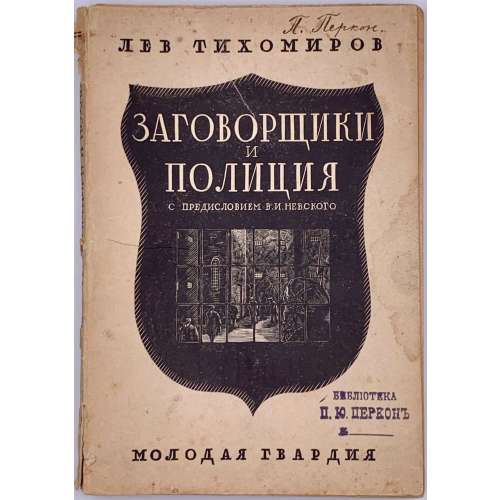 Front pictorial wrapper: ЛЕВ ТИХОМИРОВ | ЗАГОВОРЩИКИ | И | ПОЛИЦИЯ | С ПРЕДИСЛОВИЕМ В. И. НЕВСКОГО | МОЛОДАЯ ГВАРДИЯ || Title page: РЕВОЛЮЦИОННОЕ ДВИЖЕНИЕ В РОССИИ В МЕМУАРАХ | СОВРЕМЕННИКОВ | ПОД РЕДАКЦИЕЙ В. НЕВСКОГО И П. АНАТОЛЬЕВА | ЛЕВ ТИХОМИРОВ | ЗАГОВОРЩИКИ | И | ПОЛИЦИЯ | ПРЕДИСЛОВИЕ В. НЕВСКОГО | МОЛОДАЯ ГВАРДИЯ | МОСКВА – ЛЕНИНГРАД || Title verso: Обложка – гравюра на дереве | работы Н. П. Дмитровского | {printer’s device} | Издат. № 2633 | Ленинградский Областлит № 8371 | Тираж 5.000 экз. | 1928 г. Back wrapper: Заказы направлять: | [….] | {publisher’s device} | 1 р. 25 коп. | Р || Pagination: [1-3] 4-229 [3]; pp. 205-226 – notes, 227-229 – index. Collation: [1]8 2-148 154. Binding: publisher’s pictorial wrappers, lettering to spine and back cover. Print run 5,000 copies. Provenance: П. Ю. Перкон (to front cover nut-ink inscription: «П. Перкон», blue ink stamp to cover and t.p.: «БИБЛИОТЕКА | П. Ю. ПЕРКОНЪ | №» Personae: Перкон, Петр Юрьевич [Густавович] (Latvian, 1885 – 1938) — member of the communist party (Bolsheviks) since 05.1905; arrested: 05.02.1938, shot: 22.04.1938. — Previous owner. Невский, Владимир Иванович [Кривобоков or Кривобок, Феодосий Иванович] (Russian, 1876 – 1937) — arrested: 20.02.1935, shot: 26.05.1937. — Editor of the series and author of the foreword. Анатольев, П. И. [Фаресов, Анатолий Иванович; Faresov, Anatoly (Russian, 1852 – 1928). — Editor of the series. Тихомиров, Лев Александрович (Russian, 1852 – 1923). — Author of the text. Дмитревский [Дмитриевский; Дмитровский], Николай Павлович (Russian, 1890 — 1938) — arrested 15.12.1937 , shot: 02.01.1938. — Artist/engraver of the woodcut on the cover.
Front pictorial wrapper: ЛЕВ ТИХОМИРОВ | ЗАГОВОРЩИКИ | И | ПОЛИЦИЯ | С ПРЕДИСЛОВИЕМ В. И. НЕВСКОГО | МОЛОДАЯ ГВАРДИЯ || Title page: РЕВОЛЮЦИОННОЕ ДВИЖЕНИЕ В РОССИИ В МЕМУАРАХ | СОВРЕМЕННИКОВ | ПОД РЕДАКЦИЕЙ В. НЕВСКОГО И П. АНАТОЛЬЕВА | ЛЕВ ТИХОМИРОВ | ЗАГОВОРЩИКИ | И | ПОЛИЦИЯ | ПРЕДИСЛОВИЕ В. НЕВСКОГО | МОЛОДАЯ ГВАРДИЯ | МОСКВА – ЛЕНИНГРАД || Title verso: Обложка – гравюра на дереве | работы Н. П. Дмитровского | {printer’s device} | Издат. № 2633 | Ленинградский Областлит № 8371 | Тираж 5.000 экз. | 1928 г. Back wrapper: Заказы направлять: | [….] | {publisher’s device} | 1 р. 25 коп. | Р || Pagination: [1-3] 4-229 [3]; pp. 205-226 – notes, 227-229 – index. Collation: [1]8 2-148 154. Binding: publisher’s pictorial wrappers, lettering to spine and back cover. Print run 5,000 copies. Provenance: П. Ю. Перкон (to front cover nut-ink inscription: «П. Перкон», blue ink stamp to cover and t.p.: «БИБЛИОТЕКА | П. Ю. ПЕРКОНЪ | №» Personae: Перкон, Петр Юрьевич [Густавович] (Latvian, 1885 – 1938) — member of the communist party (Bolsheviks) since 05.1905; arrested: 05.02.1938, shot: 22.04.1938. — Previous owner. Невский, Владимир Иванович [Кривобоков or Кривобок, Феодосий Иванович] (Russian, 1876 – 1937) — arrested: 20.02.1935, shot: 26.05.1937. — Editor of the series and author of the foreword. Анатольев, П. И. [Фаресов, Анатолий Иванович; Faresov, Anatoly (Russian, 1852 – 1928). — Editor of the series. Тихомиров, Лев Александрович (Russian, 1852 – 1923). — Author of the text. Дмитревский [Дмитриевский; Дмитровский], Николай Павлович (Russian, 1890 — 1938) — arrested 15.12.1937 , shot: 02.01.1938. — Artist/engraver of the woodcut on the cover.


